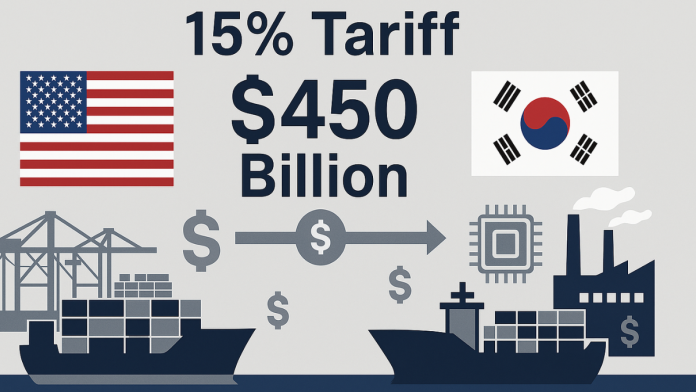A major trade breakthrough has been reached between the United States and South Korea. U.S. President Donald Trump announced a major cut in import tariffs and confirmed a series of major investment and energy deals as part of a new agreement with the Asian ally. The deal comes just ahead of a deadline for new global tariff hikes and is expected to affect key industries in both countries.
U.S. Lowers Tariffs as Part of New Agreement
The United States has officially lowered its import tariff on South Korean goods to 15%, down from a previously planned 25%. The move was part of a wide-ranging trade agreement announced in Washington after meetings between U.S. and South Korean officials.
South Korea, a major exporter of cars, steel, and semiconductors, had been facing the threat of steep new tariffs. The agreement prevented that outcome and eased trade tensions between the two nations. President Trump posted the announcement on social media, calling it a “Full and Complete Trade Deal.”
South Korea’s newly elected President Lee Jae Myung, who took office in June, said the agreement brings much-needed clarity for exporters. He also confirmed that the new tariff level is equal to or better than what other major trade partners currently face.
💣 $87 billion in danger — Trump’s 25% tariff plus penalty sends shockwaves through Indian businesses
Huge Investments and Energy Purchases Announced
As part of the deal, South Korea will invest $350 billion into U.S.-based projects over the coming years. According to Kim Yong-beom, policy chief at the South Korean presidential office, $150 billion of that will be spent on shipbuilding. The remaining $200 billion will target areas like computer chips, nuclear energy, batteries, and biotechnology.
While some of these investments were already planned, others will be part of new initiatives, according to Kim. U.S. Commerce Secretary Howard Lutnick said that 90% of the profits from the $350 billion fund are expected to benefit the American public. Kim added that the profits would be reinvested.
In addition to the investment, South Korea has agreed to purchase $100 billion in U.S. energy products over the next three and a half years. These will include liquefied natural gas (LNG), liquefied petroleum gas (LPG), crude oil, and a small amount of coal. Kim noted that these purchases fit within South Korea’s usual energy import levels but may result in a small shift away from Middle Eastern suppliers.
More Access for U.S. Products, But Some Limits Remain
The agreement will open more of South Korea’s market to American goods, including vehicles and agricultural products. Officials also confirmed it will not place import taxes on these U.S. goods.
However, they made it clear that domestic rice and beef markets will not be further opened. Discussions are still ongoing regarding U.S. concerns about food regulations.
👉 One deal, 15% tariff, and a trade war averted — inside the EU–US pact
However, South Korean officials said their domestic rice and beef markets will not be further opened. Discussions are still ongoing regarding U.S. concerns about food regulations.
South Korean automobiles entering the U.S. will now be subject to the new 15% tariff rate, a relief compared to the 25% rate that had been on the table. Meanwhile, South Korea’s semiconductor and pharmaceutical exports will not be treated any differently than those from other nations. Key materials like steel, aluminum, and copper are not included in the current agreement and remain subject to separate trade policies.
The announcement also followed key business deals by South Korean companies. Samsung Electronics finalized a $16.5 billion semiconductor supply agreement with Tesla, while LG Energy Solution signed a $4.3 billion battery deal with the same U.S. automaker.
The agreement was reached during a politically sensitive period in South Korea, where President Lee took office following the impeachment of his predecessor earlier this year. Despite having a free trade agreement in place with the U.S., South Korea has faced increasing pressure due to its large trade surplus, which reached a record $55.7 billion last year.


